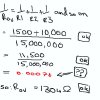Am reading through "Starting Electronics" and have come across the formula for resistors in parallel and can seem to get why the author has written the formula the way he has ?? and plus the fact that resistors in series follow what seems to be logical path, I would have thought that the same logic could have been applied to parallel resistors but apparently not or am I just missing something even more basic?? loll
I think this image may help
(the resistor values used in this example are 10k and 1k5 (the penny wont drop for me) what has me confused is the 0.000076 result I can see where he go it by dividing 15,000,000 into 11,500 , why then divide it the other way and get 1304 Ω and call that the answer sorry this probable sounds stupid but I'm just cant see the answer??
I think this image may help
(the resistor values used in this example are 10k and 1k5 (the penny wont drop for me) what has me confused is the 0.000076 result I can see where he go it by dividing 15,000,000 into 11,500 , why then divide it the other way and get 1304 Ω and call that the answer sorry this probable sounds stupid but I'm just cant see the answer??



